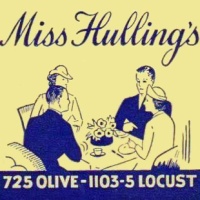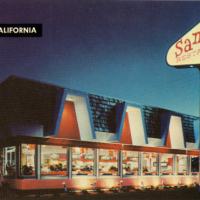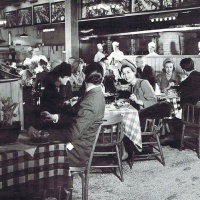Probably most patrons never give sugar a thought when they are visiting cafes and restaurants, but it is a subject that has been somewhat vexing for proprietors and guests over time.
Sugar in restaurants has figured as a health concern, an aesthetic concern, a monetary concern – and just a plain old nuisance.
For decades in the 19th and early 20th centuries, when tables were shared by strangers, a bowl of sugar was put on the table to be used by all. In the average eatery of 1830s Boston, as elsewhere, a table would typically hold a sugar bowl along with salt, butter, and other condiments.
By the late 19th century, the new-style help-yourself lunchrooms had a novel way of grouping condiments together. These were three-tier revolving trays placed in the center of round tables and holding napkins, silverware, sugar and salt, etc. They looked prim and neat – at least before the “quick lunchers” arrived.
But whether the sugar bowl resided on an 1830 oak table or a “modern” nickel-plated “Waldorf” revolving tray in a 1910s lunch room, it posed a sanitation problem.
It doesn’t take much imagination to see how shared sugar bowls could go wrong. The salty journalist who wrote under the name Fanny Fern expressed her disgust vividly in the 1850s when she described a scene at New York’s popular and well-known Taylor’s Saloon. “J-u-l-i-u-s C-ae-s-a-r! look at that white-aproned waiter pulling out his snuff-box and taking a pinch of snuff right over that bowl of white sugar, that will be handed to me in five minutes to sweeten my tea!” she exclaimed.
Along the same lines, complaints about sugar bowls that had signs of careless use were common. The cheaper the restaurant, the better the odds that the ugly cracked bowl of sugar would have coffee stains or fly specks. In the 19th and early 20th centuries, sugar bowls usually had no lids and often customers used their own spoons to dip into them. When lump sugar was used, as was often the case, diners would take pieces out of the bowl with their fingers.
Concerns about public health brought changes in the 20th century. In 1912 the U.S. Surgeon General suggested that if people would not use tongs to remove lump sugar from bowls then restaurants should switch to loose sugar, which required a spoon.
During World War I, many restaurants removed sugar bowls from their tables. Not for sanitary reasons but because they were severely restricted in the amount of sugar they were allotted. Some restaurants served no sugar while others served it only if asked, limiting the amount to one teaspoon per customer. In others, the staff put the sugar in diners’ coffee or served it in small paper packets.
By the end of the war municipal health departments around the country began to order restaurants to use covered sugar bowls, a move probably made more urgent by the nation’s deadly flu epidemic. The postwar years marked several other changes in restaurants’ ways of handling sugar, partly because prices were higher than before. Some introduced wrapped sugar cubes that were often smaller than the lumps of old, while others set out shakers rather than bowls, another method meant to discourage overuse.
Meanwhile, though, tea rooms – and fine restaurants — continued to use sugar bowls, often matching their china patterns, suggesting this was considered more refined and attractive than shakers. During the Depression a tea room consultant advised proprietors who wanted to attract male customers not to use wrapped sugar cubes because “somehow they do not know what to do with that bit of paper.” Likewise, a columnist in 1941 pitied the tired businessman seeking a restaurant meal who couldn’t “dip his spoon into a good old sugar bowl.” Instead he had to fumble with unwrapping a cube and waiting for it to dissolve in his coffee, wasting time and fraying his nerves. Poor guy, who knew?
Another age-old issue with sugar was that when its price went up, customers stole it. No doubt this occurred in the 19th century but it became a focus in news reporting beginning in World War II when sugar was rationed. Waitresses began to notice diners dumping bowls of sugar cubes into their pockets and purses. Some came prepared to steal sugar, bringing along paper bags. It didn’t take long before managers decided not to use lump sugar or discontinued placing any sugar on tables. Some began to furnish saccharin.
Stealing occurred again in 1963 and in the fall of 1974 when sugar prices tripled. The fact that many restaurants were using sugar packets by then actually made stealing easier. This time, many restaurants returned to using loose sugar. A few began to have servers provide sugar only when asked, occasionally going so far as to add a charge on the customers’ checks. [cartoon, 1975]
Things have changed since then. Sugar shakers continue to be associated with diners and lunch counters. But cubes have come up in the world. In the late 1980s a restaurant critic expressed dismay when he went to Justine’s, a restaurant that had long been regarded as one of the finest in Memphis. Among the disappointing details he noticed was the restaurant’s sugar delivery system. “Do people spending hundreds on food and wine really want to use sugar from a paper packet rather than sugar cubes?” he asked.
Today I suspect that the reduced custom of drinking coffee with meals means that restaurants provide far less sugar to customers than they used to.
© Jan Whitaker, 2022
Wishing you a sweet Valentine’s Day!


















 It's great to hear from readers and I take time to answer queries. I can't always find what you are looking for, but I do appreciate getting thank yous no matter what the outcome.
It's great to hear from readers and I take time to answer queries. I can't always find what you are looking for, but I do appreciate getting thank yous no matter what the outcome.



I’d have said this, but Jan on 13/2/22 had already done so quite well:
“Never disappointed with Jan’s articles.”
“Well researched, beautifully written, and even the most ordinary subject becomes fascinating.”
Thank you, Jan.
Thanks, Mike!
That was a sweet article. What history do you have on salt in restaurants? I once saw a guy lick the top of the salt shaker before using. That stopped my use of salt shakers in restaurants. Hahha,
Char Mack
Truly yucky! I haven’t specifically thought of an angle on salt, but you never know. Maybe I should think about a post on patrons’ bad behavior.
As always, fascinating history….. While in college (and thereafter) I worked in food service/hospitality. Sugar was always in packets in those square containers, through the 80’s those containers were used for the sugar substitutes. Can’t remember them, some were in blue packets, others in pink. One place I worked had “specs” of how many packets of each had to be stocked in those containers. I don’t care for packets in general, especially with condiments, but at least sugar dispenses easily out of them. MANY THANKS Jan, for another (as always) fascinating and entertaining history lesson….
Thanks, Mark. I don’t like packets either, whether they have sugar, catsup, mustard, or whatever. I read an opinion piece about someone counting up all the empty packets, wrappings, straws, and etc. left on a tray after she, her daughter, and a friend ate a light lunch. She was appalled.
Never disappointed with Jan’s articles.
Well researched, beautifully written, and even the most ordinary subject becomes fascinating.
Thank you! It’s great to have appreciative readers.
Sweeeeeet!